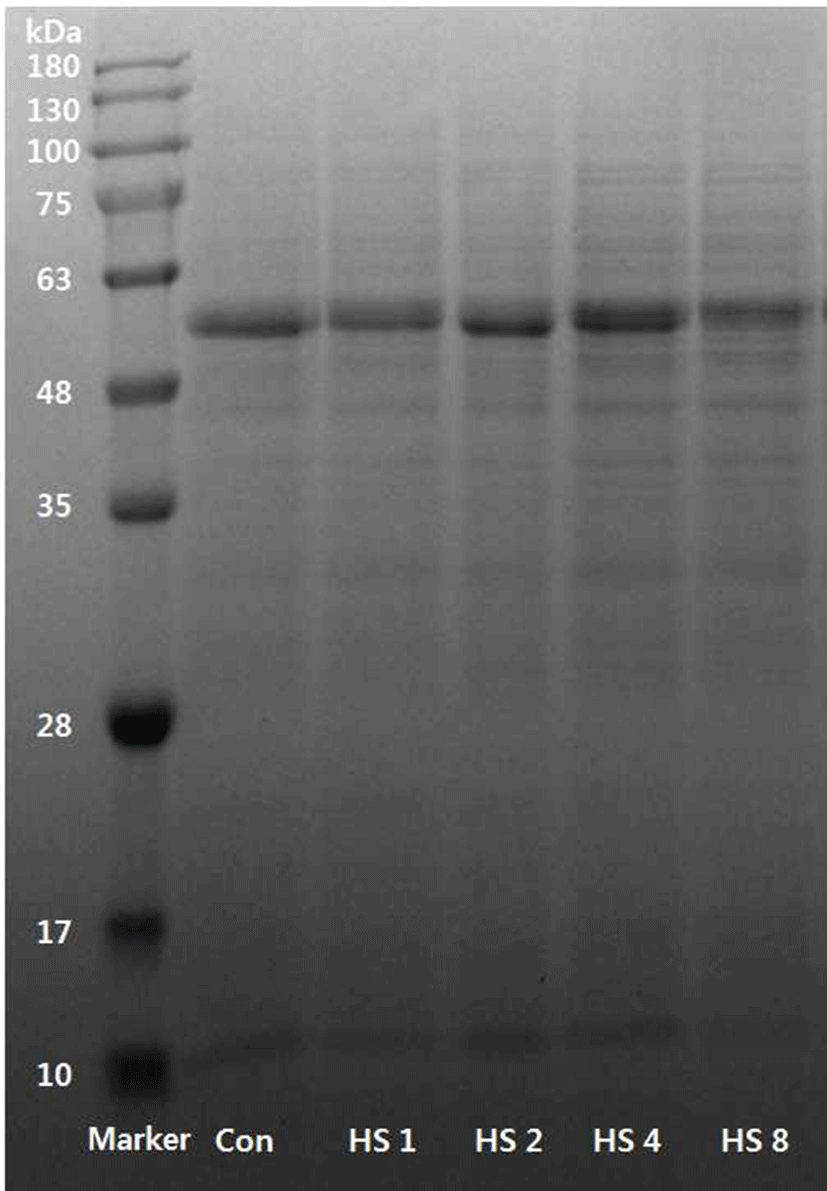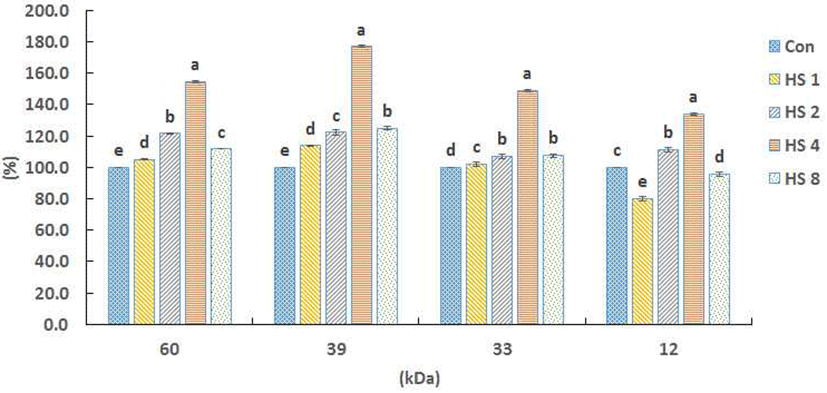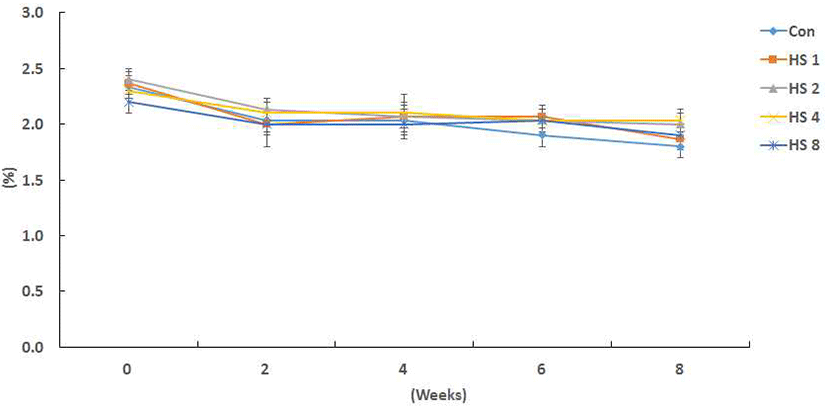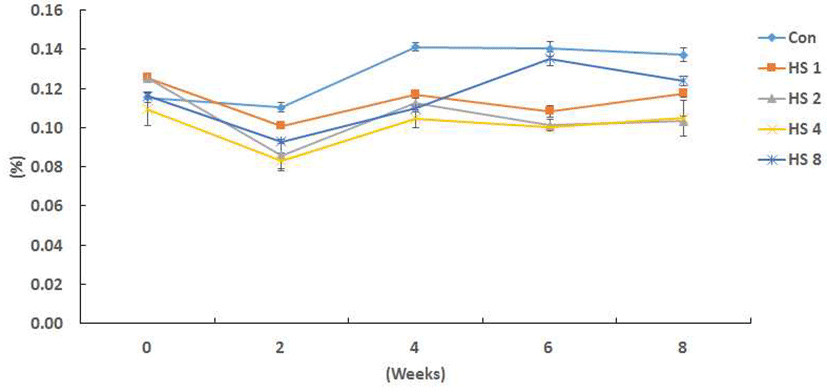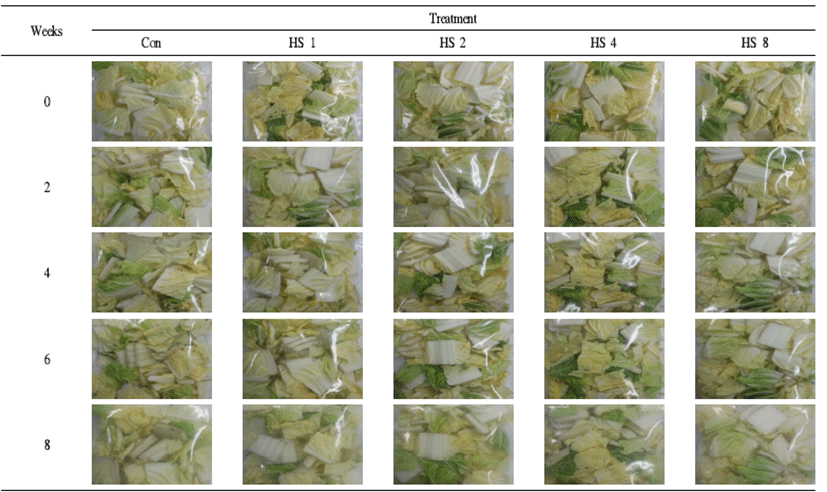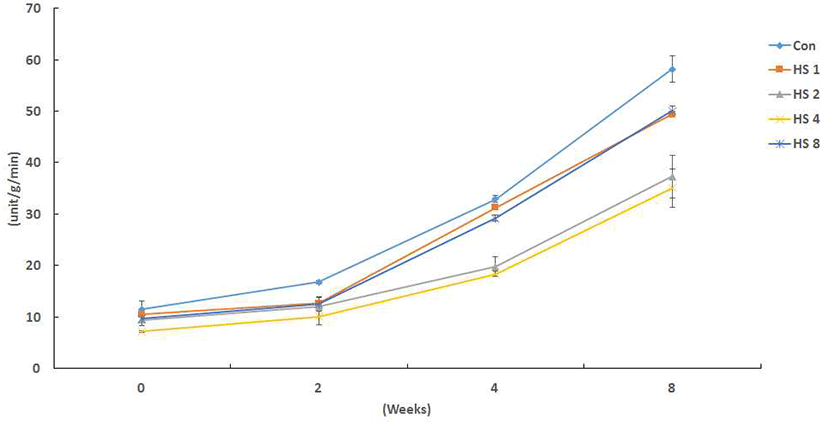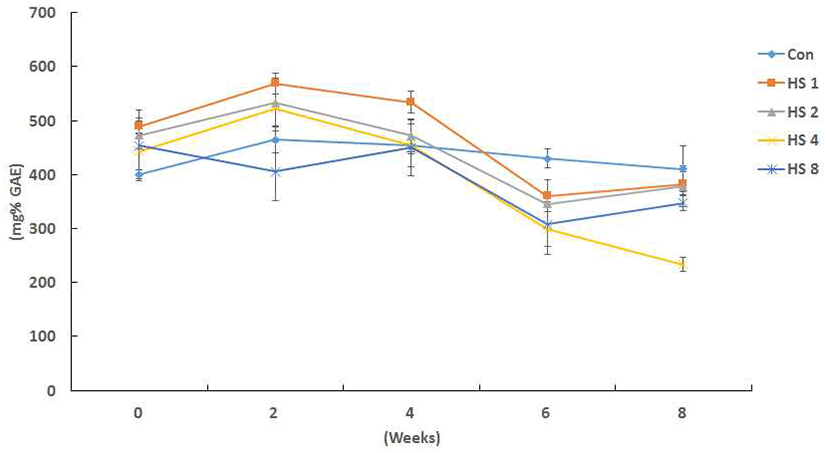ARTICLE
절단배추의 단기 저장에 대한 예열처리 효과
김상섭1, 구경형2, 정문철2, 홍주헌3, 정신교1,*
Effects of pre-heat treatments on the quality of cut kimchi cabbages during short-term storage
Sang-Seop Kim1, Kyung-Hyung Ku2, Moon-Cheol Jeong2, Joo-Heon Hong3, Shin-Kyo Chung1,*
1Department of Food Science and Technology, Kyungpook National University, Daegu 702-701, Korea
2Korea Food Research Institute, Seongnam 463-746, Korea
3Department of Food Science and Technology, Catholic University of Daegu, Gyeongsan 712-702, Korea
*Corresponding Author :
em
© The Korean Society of Food Preservation. . This is an Open-Access article distributed under the terms of the Creative Commons Attribution Non-Commercial License (http://creativecommons.org/licenses/by-nc/3.0/) which permits unrestricted non-commercial use, distribution, and reproduction in any medium, provided the original work is properly cited.
Received: Sep 1, 2014; Revised: Sep 17, 2014; Accepted: Sep 29, 2014
Abstract
Kimchi cabbages were cut (3×3 cm), and were pre-heat treated at 40°C, and their physicochemical qualities and browning degrees were investigated during 8 weeks storage at 5°C. The Cut kimchi cabbages were treated at 40°C (1~8 hrs) and their protein bands profiles were determined by sodium dodecyl sulfate polyacrylamide electrophoresis (SDS-PAGE). The 60, 39, 33, and 12 kDa bands considered heat shock proteins (HSPs) were expressed in the cut kimchi cabbage, and the 4-hr pre-heat treatment (HS 4) exhibited the strongest band ratio. The weight ratios and titratable acidities of the pre-heat treated cut kimchi cabbages were not changed so much after 8 weeks storage at 5°C, and the soluble solid contents of HS 4 decreased less than that of any other treatments. The browning degree of HS 4 after 8 week storage was also shown to be the least among the treatments. The polyphenol oxidase (PPO) activities of all treatments slightly rose during the over all storage period, in contrast with the decrease of total phenolic contents. The expression of HSPs was identified in the pre-heat treated cut kimchi cabbages, and HS 4 exhibited the best quality and appearance after 8 weeks storage at 5°C.
Keywords: kimchi cabbages; pre-heat treatments; heat shock proteins; browning degree; polyphenol oxidase
서 론
배추는 매년 2백만 톤 이상이 생산(1)되고 있으며 국내 채소 소비량의 25%를 차지하고 있다. 그러나 배추의 수요 와 공급의 균형을 기하여 재배 농가에 적절한 소득을 보장 하기 위하여는 효과적 저장법 및 새로운 상품화에 관한 연구가 필요하다.
최근 경제수준의 향상과 소득의 증가에 따라서 식품의 소비추세가 건강과 편리성을 중시하면서 신선편이 (fresh-cut) 식품에 대한 관심과 수요가 증가하고 있으며 (2,3), 이들 제품의 보존성 연장을 위한 기술 개발이 활발히 이루어지고 있다. 과채류의 수확 후 저장력 증진을 위한 방법으로는 칼슘제를 이용한 처리 방법(4), 키토산 및 왁스 처리(5), 예냉(6), controlled atmosphere(CA)저장(7), modified atmosphere packaging(MAP)저장(8), 열처리 등이 있다.
신선 과채류의 저장성을 높이기 위하여 열처리 기술을 이용하는 연구가 다양한 작물에 대해서 수행되고 있는데. 현재 상업적으로 농산물의 열처리에 널리 이용되고 있는 열처리 기술은 작물을 뜨거운 물에 담그거나 뜨거운 물을 대상 작물에 분무시키는 방법, 스팀을 이용한 열처리 그리 고 가열공기를 이용한 열처리 등(9,10)이 국내외적으로 수 행되고 있다.
열처리 기술은 농산물 노화를 억제하고 저온장해를 완화 시킬 뿐만 아니라 유해 미생물의 제어나 살균에 효과적인 방법이며(11-13), 여러 원예 작물에 저장 질환의 발생률을 감소시키는 것으로 알려져 있다(14-16). 이때 식물 중에서 생성되는 heat shock proteins(HSPs)는 해당 식물이 노출된 스트레스에 대처하기 위한 방어물질의 일종으로서 다양한 고온(17) 및 저온 환경 및 고염분 처리(18) 조건 등에서 생성된다.
절단배추는 겉절이 김치 및 샐러드 등의 용도로 소비자 에게 편의성을 제공하지만, 절단에 따른 호흡율의 증가로 인한 갈변과 품질 열화로 유통기한이 짧은 것이 단점이다. 이러한 절단 채소의 저장 중 품질 열화를 효과적으로 억제 시키기 위한 방사선, 오존 및 화학약품 처리 등의 방법(19) 이 있지만, 이들 기술에 의해서 야기되는 안전성 문제 및 또 다른 설비를 갖추어야 하는 경제적인 문제 등을 안고 있다. 이에 대하여 안전하면서도 경제성 있는 절단 배추의 저장 전 처리기술로서, Ca2+ 등 품질 보존제를 처리하여 그 효과를 보고한(20) 바 있다.
이어서 본 연구에서는 열처리에 따른 과채류의 자기방어 작용을 이용하는 환경친화적인 전처리법으로서 절단 배추 를 예열처리하여, HSPs의 생성과 단기간 냉장 저장에 따른 이화학적인 품질특성과 선도를 조사하여 그 효과를 분석하 였다.
재료 및 방법
실험 재료
실험에 사용한 배추는 전라남도 해남군에서 2014년 6월 초순경에 수확한 ‘춘황’품종(Brassica campestris L. ssp. pekinensis)으로서 화원농협(Hwawon Agricultural Cooperative, Haenam, Korea)에서 공여 받아 5°C에서 저온저장 후 시료로 사용하였다.
절단배추 예열처리 및 소포장
배추를 세척 및 탈수 후, 절단(3×3 cm)하여 항온기 내 선반에 고르게 편 후, Barnett 등(21)의 보고에 따라 40°C에 서 각각 1, 2, 4, 8시간 예열처리한 후, 0°C에서 1시간 저장하 여, 처리구별 250 g씩 low density polyethylene(LDPE) 지퍼 백(18×20 cm, 0.03 mm)에 넣어 5°C에서 8주간 저장하며 실험을 진행하였다.
이화학적 품질 특성 측정
절단 배추의 중량감소율은 처리 조건별로 시료를 취한 후 칭량하여 초기 중량에 대한 측정시의 감량률로 나타내었 다. 가용성 고형분 측정은 배추 시료 10 g에 증류수 10 mL를 가하여 마쇄하고 여과한 여과액을 굴절 당도계(Master-a, Atage Co., Tokyo, Japan)를 이용하여 측정하였다. 적정산도 는 AOAC(22) 표준시험법으로 측정하였다.
갈변도
갈변도는 Jung 등(23)의 방법으로, 배추 절단면에서 약 1 cm 가량을 잘게 잘라 2 g을 랜덤으로 취하여 유리병에 넣고, 20 mL의 증류수를 첨가하여 35°C의 water bath에서 2시간동안 추출한 뒤 여과(Whatman No 2)한 액을 UV/Visspectrophotometer(UV/Vis 1601PC, Shimadzu Co., Kyoto, Japan)를 이용하여 420 nm에서 흡광도를 측정하였다.
Polyphenol oxidase(PPO) 활성
절단배추 10 g을 0.5%의 polyvinylpolypyrrolidone(PVPP) 를 함유한 0.2 M sodium phosphate buffer(pH 7.0) 20 mL와 함께 homogenizer로 마쇄 후, 원심분리(4°C, 3,000 rpm, 10 min)하여 그 상등액을 조효소액으로 하였다. 절단배추 마쇄 시 사용한 buffer로 제조한 0.02 M의 catechol 용액 2.4 mL에 조효소액 0.8 mL를 넣은 후 420 nm에서 흡광도를 측정하였 으며, 흡광도가 1분당 0.01 변하는 것을 1 unit(U)으로 하여 specific activity(U/g)로 나타내었다(24,25).
총페놀성 화합물
총페놀성 화합물의 함량은 Prussian blue법(26)으로 측정 하였으며, gallic acid를 표준물질로 사용하여 작성한 검량 선의 회귀식에서 시료의 총페놀 함량을 구하여 mg GAE/100g(d.b.)으로 나타내었다.
SDS-PAGE(SDS-polyacrylamide gel electrophoresis) 단 백질 분석
동결건조한 절단배추를 마쇄 후 1 g 당 추출 완충액(50mM sodium phosphate pH 7.0, 10 mM β-mercaptoethanol, 10 mM EDTA pH 8.0, 0.1% Triton X-100) 1 mL을 첨가 후, 원심 분리(4°C, 12,000 rpm, 20 min)하여 얻은 상등액을 절단배추 전체 단백질에 대한 시료로 사용하였다. 단백질 정량은 BCA assay를 이용하였으며, 절단배추 조효소액 20μL에 BCA 용액(Cooper Ⅱ sulfate:Bicinchoninic acid=1:50) 160 μL을 가하여 37°C에서 1시간 방치 후, spectrophotometer (Evolution 201, Thermo Fisher Scientific Inc, Madison, WI, USA)를 이용하여 595 nm에서 각 시료의 흡광도를 측정하 였으며, bovine serum albumin(Sigma, St. Louis, MO, USA) 을 표준물질로 하여 검량선을 작성하였다. 정량한 단백질 을 sample buffer와 섞어 100°C에서 5분간 끓이고, 식힌 후 10% SDS-PAGE gel에 loading 하였고, 140 V로 전기영동장 치(Scie Ltd., Warwickshire, UK)를 이용하여 영동하고, coomassie blue 염색액에 12시간 염색 후, gel의 바탕색이 없어질 때까지 3~4회 탈색하였다. 이를 image J software (Chemi DocTMXRS+, Bio Rad, CA, USA)를 이용하여 분석 하였다.
통계처리
모든 실험 결과는 3 반복 후 그 결과 값을 SAS Program (Statistical Analysis System, SAS Institute, Inc., Cary, NC, USA)을 이용하여 분산분석과 Duncan’s multiple range test(p<0.05)를 실시하였다.
결과 및 고찰
절단배추의 적정 예열처리 조건
예열처리 시간에 따른 절단배추의 단백질 패턴은 Fig. 1에 나타낸 것과 같다. 고등식물이 열 충격에 노출되었을 때, 분자량이 60 kDa 이상인 고분자량 HSPs이외에 특징적 으로 분자량이 15-40 kDa인 small heat shock proteins(sHSP) 을 다량 합성한다는 연구(27-29)와 유사하게 예열처리시간 에 따라 단백질 밴드의 발현에 차이가 있었다. 이를 Fig. 2과 같이 Image J 프로그램을 이용하여, 대조구를 기준으로 밴드영역 값을 비교하였을 때 밴드의 식별이 용이한 60, 39, 33, 12 kDa 위치의 경우 처리 시간별 뚜렷한 밴드 발현의 차이를 확인할 수 있었다. 이때 대조구에 비하여 예열처리 구가 모두 높은 밴드 발현을 보였는데, 이중에서도 HS 4가 공통적으로 가장 높은 HSP 밴드의 발현을 나타내었다(4hr>2 hr>8 hr>1 hr>Con, p<0.05). 이는 열처리와 같은 abiotic stress를 통한 HSP 발현과 생존률의 상관을 나타낸 연구결 과(24)와 같이 저장기간 동안의 품질특성과 단백질 밴드 발현이 높은 상관관계를 나타내는 것임을 말하며, 특히 HSP60으로 추정되는 60 kDa 밴드와 sHSP의 범주안에 속하 는 39, 33, 12 kDa 밴드의 경우, 고온 처리하에 HSP 밴드의 발현이 유도 및 축적되는 것이 식물체의 내성 향상에 영향 을 끼친다는 연구결과(30,31)와 상관을 나타낼 것으로 사료 된다.
Fig. 1.
The protein band profiles of cut kimchi cabbages according to pre-heat treatments.
Marker; Molecular weight marker, Con; control, HS 1; pre-heat treatment for 1 hr at 40°C, HS 2; pre-heat treatment for 2 hr at 40°C, HS 4; pre-heat treatment for 4 hr at 40°C, HS 8; pre-heat treatment for 8 hr at 40°C.
Download Original Figure
Fig. 2.
The protein band ratios of cut kimchi cabbages according to pre-heat treatments.
Con; control, HS 1; pre-heat treatment for 1 hr at 40°C, HS 2; pre-heat treatment for 2 hr at 40°C, HS 4; pre-heat treatment for 4 hr at 40°C, HS 8; pre-heat treatment for 8 hr at 40°C.
2)abcdeMeans followed by the same letters within the each kimchi cabbages are not significantly different (p<0.05).
Download Original Figure
예열처리에 따른 절단배추의 중량 감소율을 측정한 결과 는 Table 1과 같다. 60, 120, 180, 240, 360, 480 min 예열처리 를 진행한 결과 240 min이내 예열처리시 증산작용으로 인 한 중량대비 수분손실이 5%미만으로 나타났으며, 예열처 리 후 대조구와 외관적 차이 또한 크지 않았다. 하지만 처리 360, 480 min의 경우 각각 9.81%, 13.20%의 중량대비 수분 손실이 있었으며, 외관적으로도 광택이 낮아지며, 시들해 지는 등 상품적 가치가 떨어지는 모습을 나타내었다. 이에 과채류에 40°C에서 4시간 예열처리시 HSP 의 축적이 가장 높다는 연구결과(17,21)를 바탕으로 수분손실 5% 미만 이 였던 60 min (HS 1), 120 min (HS 2), 240 min (HS 4)처리구와 지나친 열처리로 인한 차이를 확인하기 위해 수분손실 및 관능적 평가가 낮았던 480 min처리구 (HS 8)를 이용하여 실험을 진행하였다.
Table 1.
The weight ratios of cut kimchi cabbages according to pre-heat treatments
|
Treatment1) |
Con |
HS 1 |
HS 2 |
HS 3 |
HS 4 |
HS 6 |
HS 8 |
|
Weight ratio |
100.00±0.00a2) |
97.99±0.01b |
95.25±0.01c |
95.15±0.01d |
95.01±0.01e |
90.19±0.03f |
86.80±0.06g |
Download Excel Table
예열처리한 절단배추의 저장 중 이화학적 품질특성
예열처리에 따른 저장 중 절단배추의 중량감소율을 측정 한 결과는 Table 2와 같다. 예열처리구는 저장 8주차에 이르 기까지 99.71~99.73%로 각 처리구별로 유사한 중량감소율 을 나타냈으며, 대조구 포함 모든 처리구에서 저장 8주차까 지 평균 99.70%의 감소율로서 저장초기 대비 큰 차이를 나타내지 않았다. 중량감소는 주로 증산작용에 의한 것으 로서 품질에 영향을 주는 것(32)으로 알려져 있다.
가용성 고형분 함량 변화는 Fig. 3에 나타내었다. 저장초 기 대비하여 저장 2주차까지 모든 처리구에서 감소폭을 나타냈으며, 이후 저장 8주차까지 대조구의 경우 저장 2주 차의 2.0%에 비하여 약 0.2% 감소하였지만 예열처리구에 서는 평균 0.1% 감소하였다. HS 4의 경우 저장 8주차에 2.0%로 가장 낮은 감소를 나타내었다. 저장기간 중 절단배 추의 호흡 기질로 이용되어 소실되는 가용성 고형분(33)의 함량의 변화로 보아 예열처리가 대조구에 비하여 절단배추 의 수확 후 호흡을 억제하였다는 것을 알 수 있다.
Fig. 3.
Changes in the soluble solid contents of cut kimchi cabbages with pre-heat treatments dur ing 8 weeks storage at 5°C.
Con(♦); control, HS 1(■); pre-heat treatment for 1 hr at 40°C, HS 2(▲); pre-heat treatment for 2 hr at 40°C, HS 4(×); pre-heat treatment for 4 hr at 40°C, HS 8(∗); pre-heat treatment for 8 hr at 40°C.
Download Original Figure
예열처리에 따른 저장 중 절단배추의 적정 산도의 변화 는 Fig. 4에 나타내었다. 저장 초기에 비하여 대조구는 증가 하였지만, 예열처리구에서는 유의적 차이가 없었으며, HS 4가 가장 차이가 적었다. 저장 기간 중 산도의 증가는 배추 중의 당 성분이 젖산 등의 유기산으로 발효되기 때문에 일어나는 것이다(34).
Fig. 4.
Changes in the titratable acidities of cut kimchi cabbages with pre-heat treatments dur ing 8 weeks storage at 5°C.
Con(♦); control, HS 1(■); pre-heat treatment for 1 hr at 40°C, HS 2(▲); pre-heat treatment for 2 hr at 40°C, HS 4(×); pre-heat treatment for 4 hr at 40°C, HS 8(∗); pre-heat treatment for 8 hr at 40°C.
Download Original Figure
Table 2.
Changes in the weight ratios of cut kimchi cabbages with pre-heat treatments dur ing 8 weeks storage at 5°C (%)
|
Weeks |
0 |
2 |
4 |
6 |
8 |
|
Treatment1) |
|
Con |
100.00±0.010aA2) |
99.85±0.010bC |
99.78±0.000cD |
99.72±0.010dD |
99.62±0.000eC |
|
HS 1 |
100.00±0.000aA |
99.94±0.010bB |
99.85±0.010cB |
99.80±0.010dB |
99.73±0.010eA |
|
HS 2 |
100.00±0.010aA |
99.94±0.010bAB |
99.83±0.010cC |
99.79±0.010dC |
99.71±0.000eB |
|
HS 4 |
100.00±0.000aA |
99.95±0.010bA |
99.87±0.010cA |
99.82±0.010dA |
99.73±0.000eA |
|
HS 8 |
100.00±0.020aA |
99.94±0.000bbAB |
99.84±0.010cB |
99.80±0.000dBC |
99.71±0.000eB |
Download Excel Table
예열처리한 절단배추의 저장 중 갈변도
절단배추는 특히 절단 부위에서부터 갈변이 시작되므로 색도 측정시의 오차를 줄이기 위하여 추출물의 흡광도로서 갈변도를 나타내었다. 예열처리 조건에 따른 갈변도 변화 는 Table 3에 나타내었다. 모든 처리구에서 저장 2주차까지 유사한 수치를 보였지만, 이후 상승하기 시작하여, 저장 8주차 갈변도는 대조구가 저장 초기(0.036) 대비 저장 8주 차(0.113)의 갈변도 상승폭(0.077)이 가장 컸으며 HS 4는 저장 초기(0.035) 대비 저장 8주차(0.093)에 상승폭이 0.058 로 가장 낮았다(Con>HS 1>HS 8>HS 2>HS 4, p<0.05). 이는 저장기간 중 외관의 변화를 나타낸 Fig. 5와 같은 결과를 나타내었다.
Table 3.
Changes in the browning indexes of cut kimchi cabbages with pre-heat treatments dur ing 8 weeks storage at 5°C (ABS/g)
|
Weeks |
0 |
2 |
4 |
6 |
8 |
|
Treatment1) |
|
Con |
0.036±0.003dA2) |
0.043±0.004dA |
0.074±0.002cA |
0.095±0.001bA |
0.113±0.007aA |
|
HS1 |
0.032±0.002dA |
0.039±0.001dAB |
0.068±0.001cA |
0.090±0.008bA |
0.109±0.011aAB |
|
HS2 |
0.033±0.008cA |
0.031±0.001cB |
0.043±0.003cB |
0.063±0.002bBC |
0.095±0.014aB |
|
HS4 |
0.035±0.007cdA |
0.032±0.010dB |
0.046±0.006bcB |
0.057±0.002bC |
0.093±0.005aB |
|
HS8 |
0.035±0.006dA |
0.042±0.003cdA |
0.056±0.016bcB |
0.065±0.002bB |
0.105±0.003aAB |
Download Excel Table
Fig. 5.
The photos of cut kimchi cabbages with pre-heat treatments dur ing 8 weeks storage at 5°C.
Con; control, HS 1; pre-heat treatment for 1 hr at 40°C, HS 2; pre-heat treatment for 2 hr at 40°C, HS 4; pre-heat treatment for 4 hr at 40°C, HS 8; pre-heat treatment for 8 hr at 40°C.
Download Original Figure
절단배추의 저장 중 PPO의 활성 변화는 Fig. 6에 나타낸 것과 같다. 과채류의 PPO활성은 갈변정도를 판단하는 주요 지표 중 하나로서 널리 이용되고 있다. 저장기간 중 PPO활 성은 모든 구에서 증가하였으며 전반적으로 예열처리구가 대조구에 비하여 낮았으며 그 중 4시간 예열처리구가 가장 낮았다(Con>HS 1>HS 8>HS 2>HS 4, p<0.05).
Fig. 6.
Changes in the polyphenol oxidase activities of cut kimchi cabbages with pre-heat treatments dur ing 8 weeks storage at 5°C.
Con(♦); control, HS 1(■); pre-heat treatment for 1 hr at 40°C, HS 2(▲); pre-heat treatment for 2 hr at 40°C, HS 4(×); pre-heat treatment for 4 hr at 40°C, HS 8(∗); pre-heat treatment for 8 hr at 40°C.
Download Original Figure
저장기간 중 총페놀성 화합물의 함량 변화를 Fig. 7에 나타내었다. 대조구의 총페놀성 화합물 함량은 저장 기간 중 거의 일정한 수준이었으나, 예열처리구의 함량은 저장 초기에 약간 증가하였으나 후기에는 감소하는 경향이었다. 이는 예열처리에 의하여 배추의 phenylpropanoid pathway 가 활성화되어서 총페놀성 화합물이 증가하다가(35,36), PPO의 활성이 증가됨에 따라 페놀성 화합물이 기질로서 이용되어 감소한 것으로 추측할 수 있다(37). Carla Alergria 등(38)도 예열처리한 당근의 저장 중 총페놀성 화합물의 함량이 초기에는 증가하지만 후기에 감소하였다고 보고한 바 있다. 과채류의 저장 중 갈변도는 PPO 활성과 정의 상관 성이 있으며, PPO활성은 총페놀 화합물의 함량과 부의 상 관성을 보이는 것으로 보여진다(39).
Fig. 7.
Changes in the total phenolic contents of cut kimchi cabbages with pre-heat treatments dur ing 8 weeks storage at 5°C.
Con(♦); control, HS 1(■); pre-heat treatment for 1 hr at 40°C, HS 2(▲); pre-heat treatment for 2 hr at 40°C, HS 4(×); pre-heat treatment for 4 hr at 40°C, HS 8(∗); pre-heat treatment for 8 hr at 40°C.
Download Original Figure
요 약
절단 배추를 예열처리하고 LDPE 필름 포장하여 단기 저장하면서 이화학적인 품질특성과 갈변도를 조사하였다. 40°C에서 1, 2, 4, 8시간동안 예열처리한 후 SDS-PAGE 법으 로 단백질 밴드를 조사한 결과, 예열처리구에서 대조구에 비하여 HSP 밴드로 추정되는 60, 39, 33, 12 kDa 밴드가 강하게 나타났으며, 이 중 4시간 예열처리구(HS 4)가 가장 발현율이 높았으며 중량감소율도 적었다. 8주 동안 저장 중 예열처리한 절단배추의 중량감소율 및 적정산도는 거의 변화가 없었으며, 가용성 고형분 함량은 4시간 예열처리구 가 가장 적게 감소하였다. 갈변도는 HS 4가 가장 적었다 (Con>HS 1>HS 8>HS 2>HS 4, p<0.05). PPO활성은 저장 중 모든 구에서 지속적으로 증가하였으며, HS 4가 가장 낮았고 총페놀성 화합물은 모든 처리구에서 유사하게 감소 하였다. 예열처리한 절단배추에서 HSP 밴드의 발현을 확 인하였으며, 4시간 예열처리구의 단기 저장 효과가 가장 좋았다.
감사의 글
본 연구는 농림축산식품부․농림수산식품기술기획평 가원 첨단생산기술개발사업의 연구비 지원으로 수행되었 으며, 이에 감사드립니다.
References
Ministry of Agriculture and Forestry (MAF) Statistics of vegetables production amount, MAF (http;//www.mifaff.go.kr). 2012.

Choi KC, Kim MY, Chung SK. Quality changes and shelf-life of cut cabbage kimchi under various storage temperatures and packing materials. Korean J Post. Harvest Sci Technol. 1995; 2 p. 277-284.

Ahvenainen R. New approaches in improving the shelf life of minimally processed fruit and vegetables. Korean J Food Sci Technol. 1996; 7 p. 179-186


Chang KH, Byun JK. Storage potential differences of apple cultivars caused by various postharvest calcium infiltration methods. J Korean Soc Hort Sci. 1997; 32 p. 335-339.

Hwang YS, Kim YA, Lee JC. Effect of postharvest application of chitosan and wax, and ethylene scrubbing on the quality changes in stored ‘Tsugaru’ apples. J Korean Soc Hort Sci. 1998; 39 p. 579-582.

Kim BS, Kim DC, Lee SE, Nahm GB, Jeong JW. Freshness prolongation of crisphead lettuce by vaccum cooling and cold-chain system. J Korean Food Sci Technol. 1995; 27 p. 546-554.

Kim BS, Kim MJ, Choi JH. Effects of precooling treatments on the quality of peaches (Mibaek). J Korean Food Sci Technol. 2003; 35 p. 1233-1236.

Chapon JF, Blanc C, Varoquaux P. A modified atmosphere system using a nitrogen generator. Postharvest Biol Technol. 2004; 31 p. 24-28


Silliker JH, Wolfe SK. Microbiological safety considerations in controlled-atmosphere storage of meats. Food Technol. 1980; 59.

Gee DL, Brown WD. Extension of shelf life in refrigerated ground beef stored under atmosphere containing carbon dioxide and carbon monoxide. J Agric Food Chem. 1978; 26-274.

Aguayo E, Escalona VH, Artes F. Effect of hoy water treatment and various calcium salts on quality of fresh-cut 'Amarillo' melon. Postharvest Biol Technol. 2008; 47 p. 397-406


Klaiber RG, Baur S, Wolf G, Hammes WP, Carle R. Quality of minimally processed carrots as affected by warm water washing and chlorination. Innovative Food Sci Emerging Technol. 2005; 6 p. 351-362


Li Y, Brackett RE, Shewfelt RL, Beuchat LR. Changes in appearance and natural microflora on iceberg lettuce treated in warm, chlorinated water and then stored at refrigeration temperature. Food Microbiol. 2001; 18 p. 299-308


Delaquis PJ, Stewart S, Toivonen PMA, Moyls AL. Effect of warm, chlorinated water on the microbial flora of shredded iceberg lettuce. Food Res Int. 1999; 32 p. 7-17


Loaiza-Velarde JG, Mangrich ME, Campos-Vargas R, Saltveit ME. Heat shock reduces browning of fresh-cut celery petioles. Postharvest Biol Technol. 2003; 27 p. 305-311


Loaiza-Velarde JG, Tomas-Barberan FA, Saltveit ME. Effect of intensity and duration of heat-shock treatments on wound-induced phenolic metabolism in Iceberg lettuce. American J Soc Hort Sci. 1997; 122 p. 873-877.

Haslbeck M, Franzmann T, Weinfurtner D, Buchner J. Some like it hot: the structure and function of small heat-shock proteins. Nat Struct Mol Biol. 2005; 12 p. 842-846


Jiang C, Xu J, Zhang H, Zhang X, Shi J, Li M, Ming F. A cytosolic class I small heat shock protein, RcHSP17.8, of Rosa chinensis confers resistance to a variety of stresses to Escherichia coli, yeast and Arabidopsis thaliana. Plant Cell Environ. 2009; 32 p. 1046-1059.

Kim SK, Park NP. Studies on the preservation of potato by combination of gamma-radiation and chemical. Korean J Food Sci. 1975; 7 p. 159-167.

Kim SS, Seong GU, Hwang HY, Jeong MC, Chung SK. The short-term storage characteristics of cut kimchi cabbages treated with Ca2+. Korean J Food Preserv. 2014; 21 p. 157-162


Barnett T, Altschuler M, Mcdaniel CN, Mascarenhas JP. Heat shok induced proteins in plant cells. Dev Gen. 1980; 1 p. 331-340


AOAC Official Methods of Analysis. 200017th EdWashington DC., USAAssociation of official analytical chemists.

Jung JY, Shin SH, Choi JH, Jeong MC. Browning and quality changes of fresh-cut iceberg lettuce by gas flushing packagings. Korean J Hortsci Technol. 2008; 26 p. 406-412.

Rico D, Martin DAB, Barry RC, Frias JM, Henehan GRM, Barat JM. Optimisation of steamer jet-injection to extend the shelflife of fresh-cut lettuce. Postharvest Biol Technol. 2008; 48 p. 431- 442


Rico D, Martin DAB, Frias JM, Henehan GTM, Barry RC. Effect of ozone and calcium lactate treatments on browning and texture properties of fresh-cut lettuce. J Sci Food Agric. 2006; 86 p. 2179-2188


Budinin R, Tonelli D, Girotti S. Analysis of total phenols using the Prussian blue method. J Agric Food Chem. 1980; 28 p. 1236-1238


Lee GJ, Vierling E. A small heat shock protein cooperates with heat shock protein 70 systems to reactive a heat-denatured protein. Plant Physiol. 2000; 122 p. 189-197


Mansfield MA, Key JL. Synthesis of the low molecular weight heat shock proteins in plants. Plant Physiol. 1987; 84 p. 1007-1017


Park SM, cho HS, Song HW, Suh JW, Hong CB. Nicotiana tabacum low molecular weight heat shock protein cDNA clones and their expression patterns. Mol Cells. 1994; 4 p. 393-397.

Sun W, Van Montagu M, Verbruggen N. Small heat shock proteins and stress tolerance in plants. Biochim Biophys Acta. 2002; 1577 p. 1-9.

Saltveit ME. Wound induced changes in phenolic metabolism and tissue browning are altered by heat shock. Postharvest Biol Technol. 2000; 21 p. 61-69


Park WP, Kim CH, Cho SH. Quality characteristics of cherry tomato and unshiu orange packed with box incorporated with antimicrobial agents. Korean J Food Preserv. 2006; 13 p. 273-278.

Jorg A, Monica F, Renato A. Changes in sugars, acids, and amino acids during ripening and storage of apples (cv. Glockenapfel). J Agric Food Chem. 1992; 40 p. 1131-1134


Han ES, Seok MS, Park JH. Quality changes of salted baechu with pakaging methods during long term storage. Korean J Food Sci Technol. 1998; 30 p. 1307-1311.

Jacobo-Velazquez D, Martinez-Hernandez GB, del C, Rodriguez S, Cao CM, Cisneros-Zevallos L. Plants as biofactories: physiological role of reactive oxygen species on the accumulation of phenolic antioxidants in carrot tissue under wounding and hyperoxia stress. J Agric Food Chem. 2011; 59 p. 6583-6593.

Ke D, Saltveit ME. Wound-induced ethylene production, phenolic metabolism and susceptibility to russet spotting in iceberg lettuce. Plant Physiology. 1989; 76 p. 12-418


Hwang TY, Jang JH, Moon KD. Quality changes in fresh-cut potato(Slanum tubersum var. Romano) after low-temperature blanching and treatment with anti-browning agents. Korean J Food Preserv. 2009; 16 p. 199-505.

Alegria C, Pinheiro J, Duthoit M, Goncalves EM, Moldao-Martins M, Abreu M. Fresh-cut carrot quality as affected by abiotic stress pre-treatments. LWT-Food Sci Technol. 2012; p. 197-203.

Rodriguez-Lopez JN, Fenoll LG, Penalver MJ, Garcia-Ruiz PA, Varon R, Martinez-Ortiz F, Garcia-Canovas F. Tyrosinase action on monophenols; evidence for direct enzymatic release of o-diphenol. Biochim Biophys Acta. 2001; 1548 p. 238-256.

